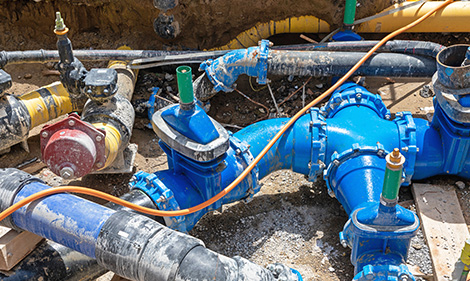

Aftermath of Recent Natural Disasters: Water and Wastewater Facilities

Poor fortune has befallen those populations hit by a major winter storm and two hurricanes in a single year. It would seem to the layperson that hard-piped water and wastewater systems would not suffer more than minimal damages. Now, the public is aware of the serious impact natural disasters have on all utilities, each needing the others. No electricity equals no water or wastewater services. Damaged system components cannot deliver services, even if the production and treatment facilities are fully capable to operate.
The state of Louisiana has been the hardest hit from hurricanes, and impacts have been experienced by all neighboring states. Though not in the “bull’s eye,” almost no state in the mid-south escaped these negative events. Many local systems were in dire shape and ill-prepared, if at all, for such calamities. Little or no utility service would be delivered for weeks.
Flood waters and storm surge destroyed roadways and bridges and dislocated buried utility pipes that used these structures for routing and support. Massive main breaks stopped any delivery of water/wastewater services, regardless of fully functional treatment facilities. Facilities suffered multiple damages and operations problems.
Louisiana had no water service to 441,000 people in 17 parishes and 319,000 under boil water notices. Residents with access to swimming pools used the water for bathing and flushing toilets. Residents were asked to refrain from using washing machines and dishwashers. Who could know where the sewage went? Damaged sewer systems pose a serious health threat, as sewage can contaminate receding flood waters. Inevitable human contact due to wading and boat rescue will expose people to multiple diseases.
American Society of Civil Engineers (ASCE) grades water/wastewater conditions for each state with Louisiana receiving the lowest, a D-, with 1,335 systems more than 50 years old. No southern state is in much better shape. Going into this situation with deficient resources had to result in widespread damage and shut downs. Many systems have lost much of their customer base due to migration of populations to larger cities. This negatively affected the rate base due to fewer people using the utility. Even with rate increases, which can induce more people to leave, money for repairs and upgrades was short, if available at all. Although regulations require back-up power, there is a widespread compliance with this and other mandates.
Transportation system damage prevented delivery of treatment supplies and fuel for back-up power, where available, so those systems capable of delivering service could not continue to do so. Wells were contaminated by flood waters and some isolated by flood waters, preventing operation and maintenance personnel from facilitating repairs or restarting the wells. Use of bottled water was necessary for drinking and tooth brushing. Hundreds of water systems were off-line.
Wastewater treatment facilities are usually constructed to allow for as much gravity flow as possible. This places the plants at low elevations, making them vulnerable to flooding. The contents of treatment vessels are washed out into the flood waters, posing a health hazard, and removal of the biomass required for successful treatment. Once the mess is cleaned up, it will be weeks to restore the biomass to levels for successful treatment of wastewater. Only seeding the facility with available biomass from another facility can shorten this process. This requires tanker truck deliveries, and the roads are mostly useless until repaired.
As we have concentrated on recent weather disasters, we have neglected another potential major disaster–earthquakes. As horrendous as the previous narrative may be, earthquakes can cause irreparable damage to the same infrastructure and facilities, comparable to the storm situations. The results will be the same, except for the potential of total destruction of treatment facilities. Destruction of water distribution and wastewater collection infrastructure would most likely be complete. Electricity will be non-existent and transportation will be shut down due to road destruction. If not for air delivery by government entities, many localities would face thirst, hunger, and lack of health services.
Lessons learned resulting in improved planning for these events should be instituted. One could suggest many methods to implement, especially when an event is predictable, but the main goal would be solid methods, such as staging supplies of bottled water for immediate delivery to those in need of it.
Regardless of the disaster planning that was already in place, things went wrong. Clearly, efforts already in place made the situation much better than nothing at all. A hard look at what worked and what didn’t work, and why, should be closely examined. All the problems described here pose an opportunity for improvement. Murphy’s Law states that if it can go wrong, it will. Whatever improved planning methods are instituted, instant response to immediate needs must take place as the event progresses.